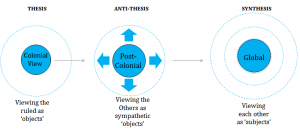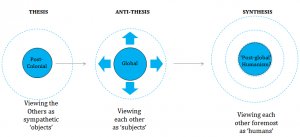The World in a Word: How ‘global’ transcends ‘post-colonial’
Advait Ubhayakar
Post-colonialism and globalism both are theoretical constructs and narrative frameworks, which are focused on engaging with the “Other”. This paper will compare the seeds of these theories — the words ‘post-colonial’ and ‘global’ — using the parameters of their aim, process, areas, audience and outcome in the Hegelian dialectic. Next, I will speculate on how they might be integrated and conclude with what this means for individuals today.
Post-colonialism here is defined as the “writing back” by authors of ‘Third World’ countries in Asia and Africa against the rule of European hegemony or dominance. Even after the Western colonial rule itself may have ended, the writing produced thereafter is still considered in the same vein. Thus the ‘post’ of ‘post-colonial’ refers both to the periods during and after colonial rule.
This body of writing can be plotted in the Hegelian dialectic as an anti-thesis to both colonial rule (political reality) and the European literary traditions (forms). As Hegel states, the contradictions (the ‘negatives’) are part of the thought itself (“the negative which it possesses within itself”). According to Hegel, the anti-thesis here acts as a balancing factor to the original thesis, producing a new synthesis, which will then continue as a new thesis. Thus, it is the inherent presence of both the positive and the negative (“the genuine dialectic moment”) that enables scientific progress.

The above diagram might seem a little counter-intuitive or even blasphemous to a post-colonial theorist. How can their efforts still make their ‘Others’ into ‘objects’? After all, all post-colonial theorists are keenly focused on giving voice to the ‘colonized Other’ — they ask ‘who’will doit (Spivak’s “Can the subaltern speak?” who speaks for them), ‘how’ it can happen (Stephen Slemon’s ‘technology of appropriation’) and ‘why’ it is necessary (Bhabha’s ‘mimicry’ of ‘reform’ to make the Other ‘recognizable’). Yet in all of them, the gaze continues to be from the Western educated position of privilege and with the intent of ‘interpreting’ and ‘explaining’ the original ‘post-colonial’ text to a (mostly Western) audience. In selecting their material and analyzing the texts, the post-colonial theorist has implicitly defined the contexts of oppression and ‘writing back’.
Consider for instance, Gayatri Spivak’s translation and reading of Mahasweta Devi’s short story, “Dopdi.” The 11-page Bengali short story locates the myth of Drapaudi from the ancient Indian epic Mahabharata to the Naxalite uprising in central India in the 1970s. Spivak’s accompanying forward begins with:
I translated this Bengali short story into English as much for the sake of its villain, Senanayak, as for its title character, Draupadi (or Dopdi). Because in Senanayak I find the closest approximation to the First World scholar in search of the Third World, I shall speak of him first.
The foreword goes on to “deconstruct” the context of Dopdi’s struggle and conflict in being not only against the prevalent policemen of the villages but also the entire colonial history of oppression and the English language itself. In the viewing, Dopdi becomes “the coalition of peasant and intellectual” whom the Western audience should empathize with as the “Other.”
Compare this with another text, the 2008 animated feature film “Sita Sings the Blues”. Here too, Sita the central female protagonist is a re-imagining of Queen Sita of the ancient Indian epic Ramayana. Yet, its author-director-singer-writer Nina Paley does not need an interpreter or interlocutor to translate it. Instead, she uses the lyrics of 1920s jazz singer Annette Hanshaw and creates a multi-layered story, complete with ironic giggling and disagreements in the recording studio with her cousins. Nina Paley credits the ancient saint Valmiki as co-writer and has made the film using commercial-free sources. On her website, she states:
From the shared culture it came, and back into the shared culture it goes. You don’t need my permission to copy, share, publish, archive, show, sell, broadcast, or remix Sita Sings the Blues. Conventional wisdom urges me to demand payment for every use of the film, but then how would people without money get to see it? How widely would the film be disseminated if it were limited by permission and fees? Control offers a false sense of security. The only real security I have is trusting you, trusting culture, and trusting freedom.
This, I submit, is a ‘global’ text. It is acutely aware of the need for connection and being understood by everyone. It also acknowledges the work as a medium and as a constantly evolving thing. And its means of production and dissemination were only possible because of today’s global culture and the Internet.
Yet today, as Suman Gupta points out in his 2009 ‘Literary Studies and Globalization’, “globalization and literature are not separate platforms from which to view the other.” There is a formative “entanglement” between literature and globalization; they share ways of understanding and manifesting.
In terms of its historical manifestation, it is tempting to posit ‘global’ as the ‘new post-colonial’. Or being ‘Global’ as the synthesis in the next phase, a reaction to be more inclusive of texts and authors that are not necessarily writing in opposition. But their differences are far greater. For the sake of brevity in this paper, I have compared them in the form of a table.

|
|
‘Post-colonial’ |
‘Global’ |
|
Intent |
To give voice to the oppressed ‘Other’ |
To connect our fragmented reality in a narrative |
|
Inherent Logic |
Understand a local text by understanding its various contexts |
Understand a local event by understanding how it is connected to other events / things |
|
Process |
Close-reading and literary analysis of a text using deconstruction or research |
Research and juxtaposition of seemingly unrelated points to ‘make sense’ together |
|
Areas of Inquiry |
Mainly literary and academic |
Literally everywhere —news, advertising, social media, mainstream Hollywood films |
|
Audience and Proponents |
Theorists, academics, students |
Everyone |
|
Outcomes |
To view an “Other” culture with sympathy or through a new local insight |
To make sense of each other as subjects, connected by a global narrative. |
One of the issues with categorizing a ‘global’ text is that literally everything made in the twenty-first century fits the bill. The Apple iPod is a global product with its line ‘Designed by Apple in California. Made in China.’ The new Godzilla film transposes the ancient Japanese monster myth onto an American city and will be released across the world translated into many languages. News and advertising is global too.
The fragmented form of a ‘global’ text is part of its identity. So is the fact that anyone can be the author of a ‘global’ text.
A girl in a Chinese province going to work in a sweatshop in Shanghai will explain her job with the same logic of ‘connection’ to the Western world in the same way as an Indian call-center worker in Gurgaon. An old woman in a small village of India will accept her grandson’s inter-caste marriage just as a second-generation Italian immigrant in Little Italy accepts his son’s marrying his African-American girlfriend.
The common logic here is simply: ‘the world is changing, we must change to and ___________ is how we are connected.’ The blank space contains the specific contexts of the authors. What this means is that the ‘global’ theory of connection and universality provides everyone the means to make connections on their own terms.
This is a fundamental difference between ‘post-colonial’ and ‘global’. While the former is a theory of ‘opposition’ and ‘differences’ (negative), the latter is driven by ‘connection’ and ‘similarity’ (positive).
Consider that old woman who has never stepped outside her village. Corporations and Big Business come to her both to the village and on the TV screen she watches. This larger narrative of ‘global’ change and its pace works to convince her to transcend her age-old traditions of caste and class, and ‘accept’ the girl her grandson has chosen. The change here would simply be expressed in “Will you be happy with her?” and “Can I meet her?” Thus, the meeting and the individual becomes the port of connection to the rest of the abstract qualities — rather that the other way around.
This is what Frantz Fanon means when he says, “I found out that he was universally right… An anti-Semite is inevitably anti-Negro.” Joined by a common point of connection — whether it is oppression or the imagination — ‘global’ allows us to make sense of our own fragmented micro-narratives.
Instead of a ‘post-colonial’ lens that would show a distant ‘other’ in a sympathetic light, ‘globalism’ allows each individual to identify with the ‘other’ as someone like them. Suman Gupta, in his “Literary Studies and Globalization”provides six methodological procedures to bring together literary studies and globalization — based on comparisons by theme, terminological and methodological common ground and using globalized literature as supporting evidence for non-literary arguments. Given how the ‘global’ lens goes beyond literary texts, the potential of this in inter-disciplinary applications are tremendous. Imagine self-identity, identification and literature all fused into a single text. A contemporary example of this is Justin Hocking’s “The Great Floodgates of the Wonderworld”, a memoir of a Californian surfer that covers everything “from the history of surfing to Scientology’s naval ties to the environmental impact of the Iraq War” using Melville’s Moby-Dick as a touchstone.
Finally, the most important point about this transition from ‘post-colonial’ to ‘global’ is that it is also reflected in real-life. A case in point: 32% more people checked more than one race in the U.S. Census between 2000 and 2010 (9 million up from 6.8 million). More than 7% of the 3.5 million children born in 2009, the year before the 2010 census, were of two or more races. The multi-racial faces are a hopeful sign of the next phase of synthesis — where we identify each other primarily as humans.

Works Cited
Gupta, Suman, Globalization and Literature, pp 62—71. Polity Press, 2009.
Lane, Richard J. (ed.), Global Literary Theory An Anthology, pp. 487—494 and pp 860—867. Routledge, Sheridan Books, 2013.
Fanon, Frantz, “The Fact of Blackness” from Black Skin, White Masks, pp 109—123. Grove Press, 1967
Spivak, Gayatri Chakravorty, A Critique of Postcolonial Reason: Toward a History of the Vanishing Present, pp. 269—281. Harvard University Press, 1999.
Spivak, Gayatri Chakravorty, “Draupadi by Mahasweta Devi” Critical Inquiry, Vol. 8, No. 2, Writing and Sexual Difference. (Winter 1981), pp 381—402. The University of Chicago Press, JSTOR.
Graywolf Press Website, “The Great Floodgates of the Wonderworld A Memoir by Justin Hocking.” About the Book. (n.d) Web. May 5, 2014.
Hegel, Georg Wilhelm Friedrich, “Hegel’s Science of Logic”, translated by A. V. Miller, George Allen & Unwin, 1969, original first published in 1812, 1813, 1816. MIA Hegel Resource https://www.marxists.org/. Andy Blunden. (n.d.) Web. April 24, 2014.
Paley, Nina. “Dear Audience” Letter on Website https://www.sitasingstheblues.com/. February 28, 2009. Web. May 5, 2014.
Cheney-Rice, Zak. “National Geographic Concludes What Americans Will Look Like in 2050, and It’s Beautiful.” Policy Mic. April 10, 2014. Web. May 4, 2014.
Cover: Image credit “The Changing Face of America” National Geographic. Martin Schoeller. October 2013. Web. May 4, 2014.